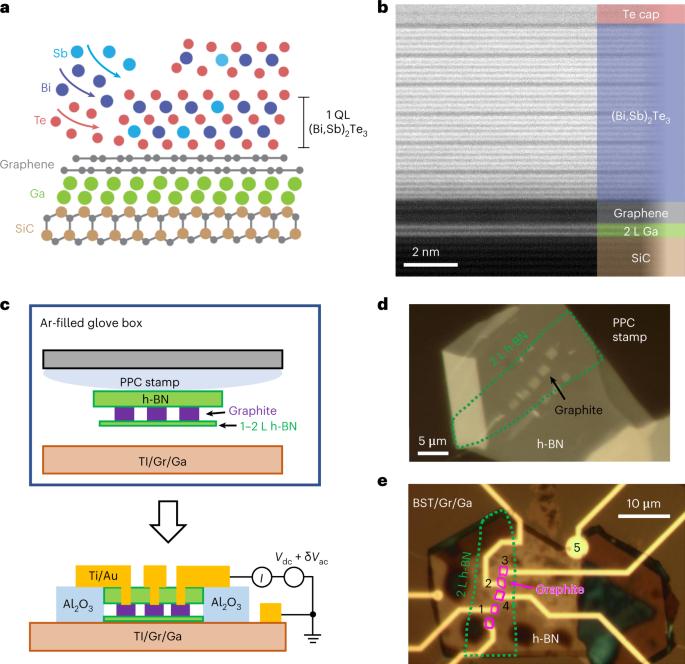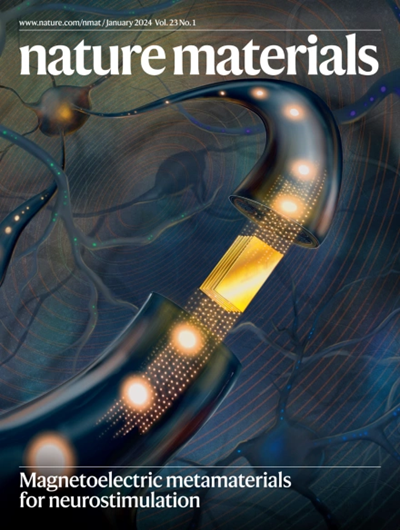Proximity-induced superconductivity in epitaxial topological insulator/graphene/gallium heterostructures
IF 38.5
1区 材料科学
Q1 CHEMISTRY, PHYSICAL
引用次数: 10
Abstract
The introduction of superconductivity to the Dirac surface states of a topological insulator leads to a topological superconductor, which may support topological quantum computing through Majorana zero modes1,2. The development of a scalable material platform is key to the realization of topological quantum computing3,4. Here we report on the growth and properties of high-quality (Bi,Sb)2Te3/graphene/gallium heterostructures. Our synthetic approach enables atomically sharp layers at both hetero-interfaces, which in turn promotes proximity-induced superconductivity that originates in the gallium film. A lithography-free, van der Waals tunnel junction is developed to perform transport tunnelling spectroscopy. We find a robust, proximity-induced superconducting gap formed in the Dirac surface states in 5–10 quintuple-layer (Bi,Sb)2Te3/graphene/gallium heterostructures. The presence of a single Abrikosov vortex, where the Majorana zero modes are expected to reside, manifests in discrete conductance changes. The present material platform opens up opportunities for understanding and harnessing the application potential of topological superconductivity. This work reports on the synthesis and proximity-induced superconductivity in a topological insulator-based, thin-film heterostructure towards the development of a scalable material platform that could potentially support robust quantum computing.

外延拓扑绝缘体/石墨烯/镓异质结构中的近距离诱导超导性
在拓扑绝缘体的狄拉克表面态中引入超导性,可形成拓扑超导体,通过马约拉纳零模支持拓扑量子计算1,2。开发可扩展的材料平台是实现拓扑量子计算的关键3,4。在此,我们报告了高质量(Bi,Sb)2Te3/石墨烯/镓异质结构的生长和特性。我们的合成方法能在两个异质界面上形成原子级的锐化层,这反过来又促进了源自镓薄膜的近距离诱导超导性。为了进行传输隧道光谱分析,我们开发了一种无光刻的范德华隧道结。我们发现,在 5-10 个五层(Bi,Sb)2Te3/石墨烯/镓异质结构的狄拉克表面态中形成了一个强大的近距离诱导超导间隙。单个阿布里科索夫涡旋的存在(预计马约拉纳零模就位于该涡旋中)表现为离散的电导变化。目前的材料平台为了解和利用拓扑超导的应用潜力提供了机会。本研究报告介绍了基于拓扑绝缘体的薄膜异质结构的合成和临近诱导超导性,旨在开发一种可扩展的材料平台,为稳健的量子计算提供潜在支持。
本文章由计算机程序翻译,如有差异,请以英文原文为准。
求助全文
约1分钟内获得全文
求助全文
来源期刊

Nature Materials
工程技术-材料科学:综合
CiteScore
62.20
自引率
0.70%
发文量
221
审稿时长
3.2 months
期刊介绍:
Nature Materials is a monthly multi-disciplinary journal aimed at bringing together cutting-edge research across the entire spectrum of materials science and engineering. It covers all applied and fundamental aspects of the synthesis/processing, structure/composition, properties, and performance of materials. The journal recognizes that materials research has an increasing impact on classical disciplines such as physics, chemistry, and biology.
Additionally, Nature Materials provides a forum for the development of a common identity among materials scientists and encourages interdisciplinary collaboration. It takes an integrated and balanced approach to all areas of materials research, fostering the exchange of ideas between scientists involved in different disciplines.
Nature Materials is an invaluable resource for scientists in academia and industry who are active in discovering and developing materials and materials-related concepts. It offers engaging and informative papers of exceptional significance and quality, with the aim of influencing the development of society in the future.
 求助内容:
求助内容: 应助结果提醒方式:
应助结果提醒方式:


